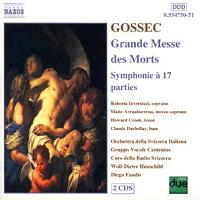
Buried masterpiece?
RODERIC DUNNETT is bowled over by Gossec's Requiem
Naxos 8.554750-51
|

|
Is there no end to the number of buried masterpieces? From budget price
Naxos, that beacon of rediscovery, comes a double disc of the Requiem by
Gossec -- one of the undoubtedly greatest of Mozart and Haydn contemporaries.
It's quite simply superb [listen -- CD 1 track
1, 0:03-1:14].
Born in Belgian Flanders (Hainault) in 1734, François-Joseph Gossec
was a boy chorister in Antwerp, moved to the French capital, and (in the
Vicar of Bray tradition among musicians of the day -- like Cherubini, Méhul,
Lesueur) served Royalty (the Princes de Condé and Conti) and the
Revolution alike. While Mozart was scarce out of swaddling bands, Gossec's
comic operas were the rage of 1760s Paris. While Robespierre ranted, he
directed the band of the Garde Nationale and served up Jacobin ditties.
He pioneered the use of clarinets and wrote some fifty vital symphonies
(now beginning to emerge, with slightly mixed results, from the Orchestre
de Bretagne conducted by Stefan Sanderling, on the ASV label, CD DCA
1123 and 1124).
This Messe des Morts is head and shoulders above almost any of
his early contemporaries. The mere idea that anyone could pen such a Requiem
in 1760 defies belief. It makes not Germany but France seem -- in choral
music as in Gluckian drama -- the nursemaid of Classicism. The chorus from
Radio Svizzera Italiana in Lugano -- among sometimes (without meaning to
be cruel) desultory Italian recordings -- is shockingly good. The opening
is spellbinding. The Gradual fugue 'Et lux perpetua' knocks Haydn's
Creation for six.
And just when you think it might run out of puff, a searing 'Dies Irae'
[listen -- CD 1 track 7, 0:57-1:40] takes you by
storm. There are a thousand subtle details that make this recording first-rate.
The soloists are terrific. Gossec's 'Tuba mirum' already
sounds like a Napoleonic call-to-arms; 'Quantus tremor' makes
Verdi look tame; 'Confutatis maledictis' confronts the jaws of
Hell itself, like a shivering foretaste of Don Giovanni. The single-bar
ostinato (effectively a passacaglia), 'Recordare', with mezzo-soprano,
is astonishing [listen -- CD 1 track 11, 0:40-1:42].
And that's before you hit the Lacrymosa, rapt Offertorium and 'Et
lux perpetua' fugal finale. Berlioz and Gounod garnered not a few of
their best ideas from composers of the Gossec era; but few delivered this
kind of unyielding consistency, melodic-harmonic vividness and untrammelled
dramatic power.
Alternative versions do exist, of which I should mention a very good
Belgian one (on Erato 2292 45284 2 / Apex 8573 89234 2), virtually
a rival, directed by Louis Devos -- the strings on both this and the Naxos
are simply magnificent. The offering from Koch-Schwann (313 041 K2)
under Jacques Houtmann and the Orchestre Symphonique de Liege, though attractively
packaged, is less impressive in its reading, rather muzzy in sound quality
and needlessly spreads onto a second disc, though does catch something of
the Berliozian string feel and appends -- to advantage -- Gossec's striking
Symphonie a Dix-sept Parties in F of 1809, audibly a work from the
Beethoven era. (Gossec lived on to 1829 and the age of 95, so this Belgian
farmer's son outlived the lot.) But I'd go straight for this thrilling
-- and terrifying -- Naxos recording : it hits one like a thunderclap, and
never lets up.
Copyright © 12 October 2002
Roderic Dunnett, Coventry, UK

Gossec: Grande Messe des Morts
8.554750-51 DDD Stereo (2 CDs) 60'02"/51'41" - TT 111'33" 2001 HNH International Ltd
Roberta Invernizzi, soprano, Maite Arruabarrena, mezzo-soprano, Howard Crook, tenor, Claude Darbellay, bass, Gruppo Vocale Cantemus, Coro della Radio Svizzera, Orchestra della Svizzera Italiana, Wolf-Dieter Hauschild, conductor (symphony), Diego Fasolis, conductor (Requiem)
François-Joseph Gossec (1734-1829): Messe des Morts (Introduzione: Grave, Introitus, Graduale, Sequentia, Offertorium, Sanctus, Pie Jesu, Agnus Dei, Post Communionem); Symphonie à 17 parties |
PURCHASE THIS DISC FROM AMAZON
PURCHASE THIS DISC FROM CROTCHET
Record Box is Music & Vision's
regular Saturday series of shorter CD reviews
|

